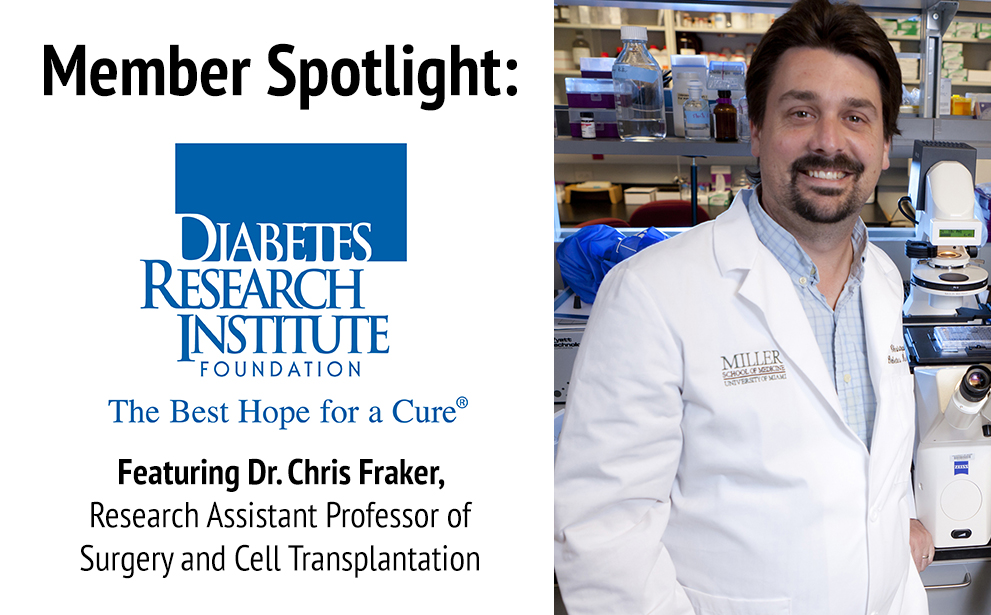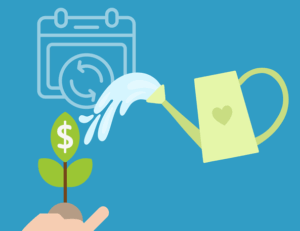Sarah Ford | September 16, 2015
Committed and Driven to Find a Cure for Diabetes
Diabetes Research Institute Foundation (DRIF) exists for one reason: to provide the Diabetes Research Institute with the funding necessary to cure diabetes now. The DRIF’s history of commitment dates back to 1971 when it was founded by a small group of parents of children with diabetes who were dedicated to finding a cure. Today, the Diabetes Research Institute leads the world in cure-focused research. As the largest and most comprehensive research center dedicated to curing diabetes, the DRI is aggressively working to shrink the timeline toward the discovery of a biological cure for this disease.
In this blog post, Chris Fraker, Research Assistant Professor of Surgery and Cell Transplantation at Diabetes Research Institute Foundation, shares what attracted him to DRIF, along with some exciting developments happening right now for the millions of people affected by diabetes.
Q&A With Dr. Chris Fraker:
What attracted you to this job & particular cause?
I was diagnosed with type 1 diabetes just before my 16th birthday. Today, 30 years later, I’m starting to develop low-level complications and my children have the markers for the disease. So, as you can imagine, I’m motivated to find a cure.
Early in my career, I was involved in more treatment-based work: designing implantable glucose sensors with the hope of coupling them with insulin pumps. But I knew that was never going to lead to a true cure. I found the cellular-based therapy work being done at the DRI fascinating, and I literally badgered Dr. Camillo Ricordi, the DRI’s Scientific Director, until he hired me. That was 15 years ago, and there’s a simple reason I’m still here. Everyone at the DRI and at the DRI Foundation is committed and driven to find a cure. It’s a remarkable place.
How are you making an impact through your work?
Over the last several years, the Diabetes Research Institute has shown the extraordinary potential of transplanting insulin-producing cells to restore insulin function. While progress has been substantial, this remains an experimental procedure. We are working to overcome the remaining challenges that limit its widespread use.
One of the major challenges is to identify a new site in the body in which to transplant the new cells, as the liver is no longer thought to be an optimal environment. Our goal is to identify a site that closely mimics the native environment of the pancreas to give transplanted insulin-producing cells the best chance at long-term survival. The availability of oxygen is key to creating an optimized site; islets make up only 1-2 percent of the entire pancreas where they reside, yet they use almost 25 percent of the oxygen that flows through the organ.
My focus is on developing ways to deliver that level of oxygen to the insulin-producing cells. I am also testing several strategies to deliver the vital oxygen levels more effectively. Achieving the required amounts of oxygen is critical in our efforts to cure diabetes. Additionally, I am heavily involved with the immunology team at the DRI looking at unique ways to protect transplanted cells from the immune response and to repair the damaged immune system in T1D patients.
What advice would you give to anyone with a similar position, or to someone interested in working for a nonprofit like yours?
Always remember why you chose this line of work in the first place. Even as a diabetes patient, I am reminded when I meet the many families who tour our facility. When I see the parents come in and see their eyes well up with tears, I understand that it’s not just about the patient. And I want to take that worry and fear away from them. They motivate me to work even harder so I can say to them, “It’s over. You can sleep easy and sleep through the whole night. Your child is going to be okay and wake up tomorrow just fine.”
What excites you most about your organization’s work right now?
In mid-August we successfully transplanted insulin-producing cells into the first patient in a clinical trial testing the omentum, an apron-like lining inside the abdomen, as a new transplant site for these cells. I am thrilled to report that the patient, Wendy Peacock, 43, from San Antonio, TX, has been freed from insulin injections in record time. She is now producing her own insulin naturally for the first time since being diagnosed with type 1 diabetes at age 17. These are the best early post-transplant results we’ve seen in any of our transplant recipients.
I’d like to thank you as supporters. Without the private support that we receive at our institute, we would not be able to carry on this research at the pace we do in our race to find a cure for diabetes.
Our thanks to Dr. Chris Fraker for sharing his time and expertise with us! To learn more about the impact Chris’s organization is making, click here to visit their website and connect with them on Facebook, Twitter @Diabetes_DRI, and on YouTube.
Sign-up for our newsletter to receive blog posts and other resources.

Get Resources and Insights Straight To Your Inbox
Explore More Articles
Nurturing Payroll Giving Donors: 5 Tips to Deepen Engagement
Payroll giving donors are some of the most consistent and committed supporters nonprofits have, but they’re often overlooked in day-to-day fundraising strategies. These donors contribute…
Read ArticleHow to Align Your Company’s Values with Your Hiring Process
Hiring is about more than filling roles—it’s about shaping the future of your company. Every new team member contributes to the culture you’re building, and…
Read ArticleGet Resources and Insights Straight To Your Inbox
Receive our monthly/bi-monthly newsletter filled with information about causes, nonprofit impact, and topics important for corporate social responsibility and employee engagement professionals, including disaster response, workplace giving, matching gifts, employee assistance funds, volunteering, scholarship award program management, grantmaking, and other philanthropic initiatives.




